 W
WThe Altamura Man is a fossil of the genus Homo discovered in 1993 in a karst sinkhole in the Lamalunga Cave near the city of Altamura, Italy.
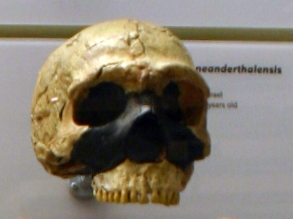 W
WAmud 1 is a nearly complete but poorly preserved adult Southwest Asian Neanderthal skeleton thought to be about 55,000 years old. It was discovered at Amud in Israel by Hisashi Suzuki in July 1961, who described it as male. With an estimated height of 1.78 m, it is considerably taller than any other known Neanderthal, and its skull has by far the largest cranial capacity of any archaic hominin skull ever found. Making it, according to Ralph Holloway, one of the most famous specimens of Neanderthal skulls.
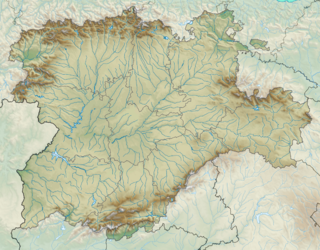 W
WThe Atapuerca Mountains is a karstic hill formation near the village of Atapuerca, in the Province of Burgos, northern Spain. In a still ongoing excavation campaign, rich fossil deposits and stone tool assemblages were discovered which are attributed to the earliest known hominin residents in Western Europe. This "exceptional reserve of data" has been deposited during extensive Lower Paleolithic presence, as the Atapuerca Mountains served as the preferred occupation site of Homo erectus, Homo antecessor, Homo heidelbergensis and Homo neanderthalensis communities. The earliest specimen so far unearthed and reliably dated confirm an age between 1.2 million and 630,000 years. Some finds are exhibited in the nearby Museum of Human Evolution, in Burgos.
 W
WAzykhantrop, or "Azyk Man", is the lower jaw of a presumably female Homo heidelbergensis pre-Neanderthal. The fossil was found in Azykh Cave, Fuzuli, Azerbaijan SSR, in 1968, by Azerbaijani Mammadali Huseynov.
 W
WThe Ehringsdorf remains are the fragments of at least nine early Neanderthal individuals, exhumed from a deposit of limestone at the Ehringsdorf quarries along the Ilm River, roughly 2.4 km (1.49 mi) from Weimar, Germany. The deposits in which this skull were found included elephant, rhinoceros, horse, and bovid fossil remains and came from the travertines belonging to the second half of the last (Eemian) interglacial period. The estimated age of the remains is between 150,000 and 120,000 years. The remains' characteristics typical of early Neanderthals include the size of the brow ridges, the long and low brain case, and the strong chinless lower jaw.
 W
WEngis 2 refers to part of an assemblage, discovered in 1829 by Dutch physician and naturalist Philippe-Charles Schmerling in the lower of the Schmerling Caves. The pieces that make up Engis 2 are a partially preserved calvaria (cranium) and associated fragments of an upper and a lower jaw, a maxillary bone and an upper incisor tooth of a two to three year old Neanderthal child. The Schmerling Caves are situated just north of the Belgian municipality Engis, whence the name of this group. In 1833 Schmerling described and publicized the find, which included animal bones and stone tools. Recognizing their old age, he associated them with the "Ethiopian Type" of the diluvial period. Although it was not recognized as such until 1936, the publication represents the first scientific description of a Neanderthal fossil.
 W
WGibraltar 1 is the specimen name of a Neanderthal skull, also known as the Gibraltar Skull found at Forbes' Quarry in Gibraltar and presented to the Gibraltar Scientific Society by its Secretary, Lieutenant Edmund Henry Réné Flint on 3 March 1848. Its discovery predates that of the Neanderthal type specimen.
 W
WGibraltar 2, also known as Devil's Tower Child, represented five skull fragments of a male Neanderthal child discovered in the British Overseas Territory of Gibraltar. The discovery of the fossils at the Devil's Tower Mousterian rock shelter was made by archaeologist Dorothy Garrod in 1926. It represented the second excavation of a Neanderthal skull in Gibraltar, after Gibraltar 1, the second Neanderthal skull ever found. In the early twenty-first century, Gibraltar 2 underwent reconstruction.
 W
WThe Goyet Caves are a series of connected caves located in a limestone cliff about 15 m above the river Samson near the village of Mozet in the Gesves municipality of the Namur province, Belgium. The site is a significant locality of regional Neanderthal and European early modern human occupation, as thousands of fossils and artifacts were discovered that are all attributed to a long and contiguous stratigraphic sequence from 120,000 years ago, the Middle Palaeolithic to less than 5.000 years ago, the late Neolithic. A robust sequence of sediments was identified during extensive excavations by geologist Edouard Dupont, who undertook the first probings as early as 1867. The site was added to the Belgian National Heritage register in 1976.
 W
WKebara 2 is a 60,000 year-old Levantine Neanderthal mid-body male skeleton. It was discovered in 1983 by Ofer Bar-Yosef, Baruch Arensburg, and Bernard Vandermeersch in a Mousterian layer of Kebara Cave, Israel. To the excavators, its disposition suggested it had been deliberately buried, though like every other putative Middle Palaeolithic intentional burial, this has been questioned.
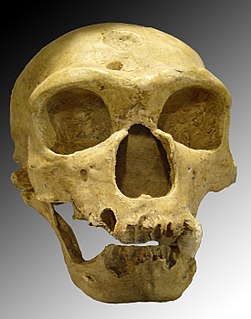 W
WLa Chapelle-aux-Saints 1 is an almost-complete male Neanderthal skeleton discovered in La Chapelle-aux-Saints, France by A. and J. Bouyssonie, and L. Bardon in 1908. The individual was about 40 years of age at the time of his death. He was in bad health, having lost most of his teeth and suffering from resorption of bone in the mandible and advanced arthritis.
 W
WLa Ferrassie 1 is a male Neanderthal skeleton estimated to be 70–50,000 years old. La Ferrassie 1 is often referred to as LF1. It was discovered at the La Ferrassie site in France by Louis Capitan and Denis Peyrony in 1909. The skull is the most complete Neanderthal skull ever found. With a cranial capacity of 1641 cm3, it is the second largest hominid skull ever discovered, after Amud 1, another Neanderthal.
 W
WMiguelón is the popular nickname for a human skull, classified as either late Homo heidelbergensis or as early Homo neanderthalensis. It has been estimated to date to 430,000 years ago. It is one of more than 5,500 fossils belonging to early human populations which have been found in the Sima de los Huesos site in the Sierra de Atapuerca in northern Spain.
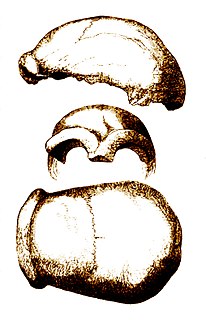 W
WFeldhofer 1, or Neanderthal 1 is the scientific name of the 40,000-year-old type specimen fossil of the species Homo neanderthalensis, found in August 1856 in a German cave, the Kleine Feldhofer Grotte in the Neandertal valley, 13 km (8.1 mi) east of Düsseldorf. In 1864 the fossil's description was first published in a scientific magazine and officially named.
 W
WTwo fossil crania were discovered along the Aniene River Valley of Northern Rome, Italy in 1929 and 1935. The two human skulls that derive from Homo neanderthalensis were located in a quarry along the Aniene River in gravel and sand beds that have since been replaced by building areas with the city. From geomorphological classification, the two skulls were assigned to the Tyrrhenian stage due to their location within a small hill approximately 5 meters above the river. The area in which they were found at the time was called Saccopastore, which is where these two crania get their name. The first Saccopastore skull, discovered by Sergio Sergi, and the second Saccopastore skull, discovered by Professors Breuil and Blanc, both show greater basicranial flexion compared to those of the Wurmian Neandertals, due to the extreme inclination of the planum sphenoidalis. The skulls' ages likely ranges from 100,000 to 300,000 years, and they show an extremely high level of fossilisation. After being discovered, the skulls were kept at the Institute of Anthropology of the University of Rome until World War II, when they were taken by Professor Sergio Sergi to be preserved and kept safe from German officers who were seeking fossil treasures. After a time, they stayed with Sergi and became part of his own private collection.
 W
WThe Schmerling Caves are a group of caves on the right bank of the stream called the Awirs, near the village of Awirs in Flémalle, Belgium. The caves are notable for their past fossil finds, particularly of hominins. They were explored in 1829 by Philippe-Charles Schmerling, who discovered, in the lower cave, the remains of two individuals, one of which, now known as Engis 2, was a fossil of the first Neanderthal ever found; the other was a Neolithic homo sapiens. Also known as Trô Cwaheur or Trou Caheur, this lower cave has since collapsed. A third cave was destroyed because of work on the adjacent quarry, the Ancienne Carrière des Awirs.
 W
WShanidar Cave is an archaeological site located on Bradost Mountain in the Erbil Governorate of Kurdistan Region in northern Iraq. Anthropologist Ralph Solecki led a crew from Columbia University to explore the site. With the accompaniment of Kurdish workers, the group excavated the Shanidar Cave and found the remains of eight adult and two infant Neanderthals, dating from around 65,000–35,000 years ago. These individuals were uncovered amongst a Mousterian layer accompanied by various stone tools and animal remains. The cave also contains two later proto-Neolithic cemeteries, one of which dates back about 10,600 years and contains 35 individuals.
 W
WThe archaeological site of Atapuerca is located on the Atapuerca Mountains in the north of Spain. The archaeological significance of the area became increasingly apparent during the construction of a railway line as deep trenches were cut through the rocks and sediments of the Gran Dolina site, the Galería Elefante and at Sima de los Huesos. The subsequent excavation of 1964 under the direction of Francisco Jordá Cerdá succeeded with the discovery of anthropogenic artifacts and human fossils from a broad time range of early humans, hunter-gatherer groups to Bronze Age occupants and modern human settlers. Further campaigns expanded and interdisciplinary work has been undertaken by several teams, led by Emiliano Aguirre from 1978 to 1990 and later jointly by Eudald Carbonell, José María Bermúdez de Castro and Juan Luis Arsuaga.
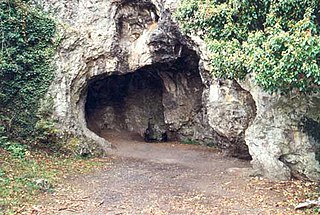 W
WSpy Cave is located near Spy in the municipality of Jemeppe-sur-Sambre, province of Namur, Belgium above the left bank of the Orneau River. Classified as a premier Heritage site of the Walloon Region, the location ranks among the most significant paleolithic sites in Europe. The cave consists of numerous small chambers and corridors.
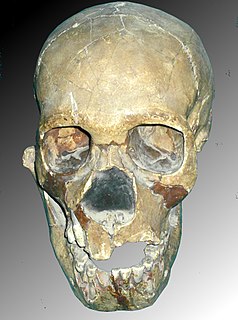 W
WTeshik-Tash 1 is a Neanderthal skeleton discovered in 1938 in Teshik-Tash Cave, in the Bajsuntau mountain range, Uzbek SSR, central Asia.
 W
WTrou de l’Abîme also known as La caverne de l'Abîme and Couvin Cave is a karst cave located on the right bank of the Eau Noire river in the center of Couvin, Belgium, in Namur province. During various archaeological excavations of sediment deposits Mousterian artefacts and a Neanderthal molar were discovered.
 W
WThe Wezmeh Cave is an archaeological site near Islamabad Gharb, western Iran, around 470 km (290 mi) southwest of the capital Tehran. The site was discovered in 1999 and excavated in 2001 by a team of Iranian archaeologists under the leadership of Dr. Kamyar Abdi. Wezmeh cave was re-excavated by a team under direction of Fereidoun Biglari in 2019.
 W
WWezmeh Child or Wezmeh 1 represented by an isolated unerupted human maxillary right premolar tooth of an individual between 6–10 years old. It was found with large numbers of animal fossil remains in a cave site called Wezmeh near Islamabad Gharb, western Iran, around 470 km (290 mi) southwest of the capital Tehran. The site was discovered in 1999.